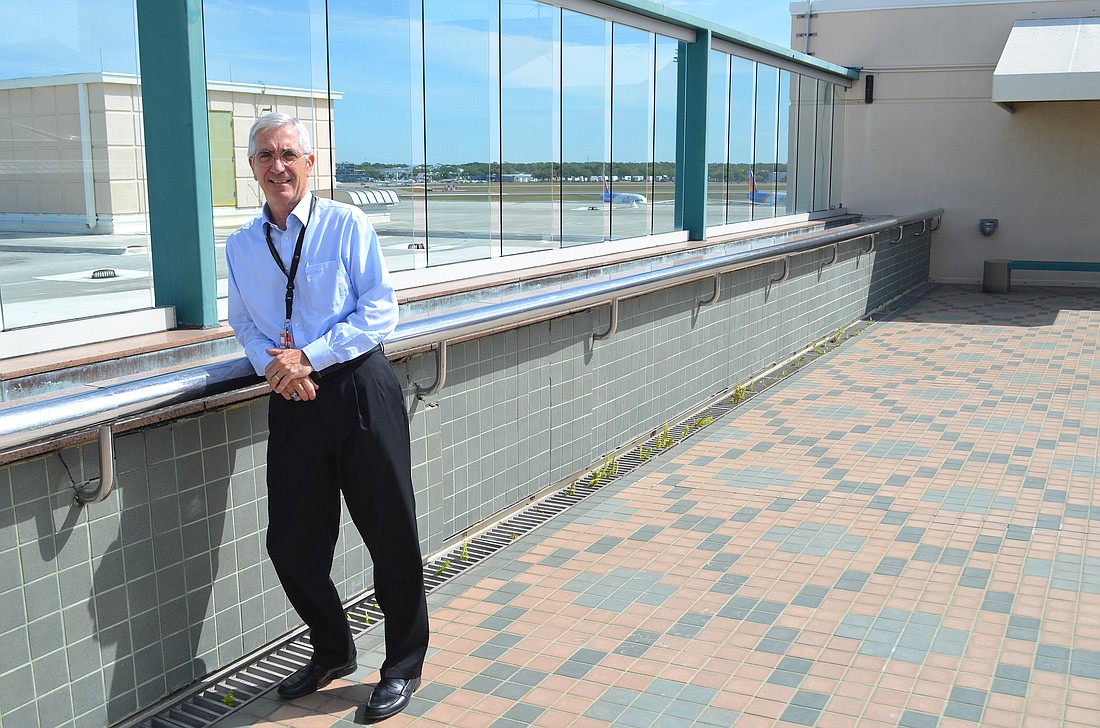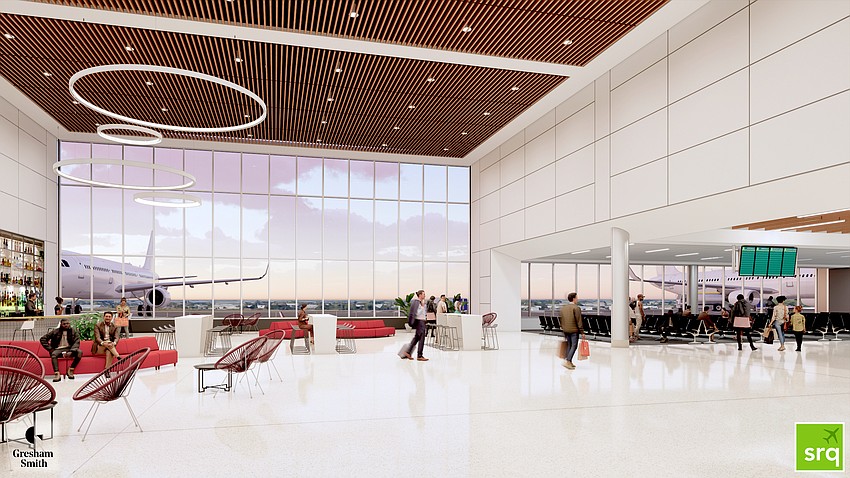- April 11, 2025
-
-
Loading

Loading

Earth is being moved both on the airfield and the perimeter of Sarasota-Bradenton International Airport as work to keep pace with the rapid growth in passengers is underway.
In early March, the Sarasota-Manatee Airport Authority Board of Directors approved a major work package covering all the vertical construction of the new ground-based boarding concourse adding five new gates and bringing to 18 the total number of gates at the airport. The $71.5 million contract will build Concourse A, which will include a separate entrance, TSA screening and concession facilities.
That, in addition to a previously approved escalator and utilities upgrade package of $17 million, plus a future second expansion to bridge the new concourse — bringing with it three more elevated gates, a new baggage handling system and improvements to the existing Concourse B — represents a $100 million investment.
Meanwhile, site prep is underway on airport property along University Parkway at Old Bradenton Road on the first of several phases of parking expansion that will eventually culminate in a vertical parking structure either on the current short-term lot or on land nearby.
The work is in anticipation of the need to facilitate continued growth of SRQ in the wake of COVID-19. Rick Piccolo, the airport’s president and CEO, anticipates 4.5 million passengers traveling through SRQ this year. When all the work is complete, he said the airport could accommodate upwards of 8 million or more per year. By comparison, in 2018 the airport served 1.8 million passengers.

Many of those travelers will need somewhere to park, a commodity currently in short supply at SRQ.
“We are building remote surface parking areas, and they will become our overflow lots,” Piccolo said. “Those are under contract and started construction. We hope to have all those ready by Thanksgiving. And then what we have to do is build enough excess spaces so that we have maybe 1,000 extra spaces beyond what are our needs are right now.”
It’s a long way since the dark days of the onset of the pandemic, when the commercial airline industry was all but shut down across the country. Not immune to the impact of the immediate response, SRQ had its worst month in April 2020, whenu fewer than 10,000 passengers passed through the airport. This after growth of 43% in 2019.
Like all other airport directors across the country, Piccolo was crunching numbers to determine how long the airport could operate. SRQ receives no local tax funding. As an authority, its revenues come from land and building leases around and outside the airfield, parking, landing fees, fuel fees and a percentage of sales from food and beverage, news and gifts.
SRQ facilitates virtually no air cargo, a major revenue source for many airports. Its budget is highly dependent on passengers, and Piccolo had no idea when they would be returning.
“I walked out into the parking lot and we had 25 cars out there, and I was concerned because our business model is dependent on passengers,” he said. “We had about $15 million in reserves at that time and our budget would have eaten that up in about eight months.”
Many airports at the time were down 75% to more than 90% in passengers. Meanwhile, Florida was being discovered and a large share of those who were traveling came here, helping SRQ recover faster than most.
“I felt bad because we would have monthly conference calls with all my colleagues and the FAA over how people were faring in this problematic COVID atmosphere, and I would keep my mouth shut because I felt guilty,” Piccolo said. “Everybody else was talking about how they're still down 50% or down 70%, and I'm sitting there up 155%. I thought I’m just going to keep my mouth shut because I had nothing to complain about.”
Like other airports, CARES Act funding in the amount of $37 million helped keep the doors open during those slow early months — operating expenses don’t stop because there are few passengers — and SRQ has since built its reserves to $60 million.
Those reserves are not enough to cover all the capital improvements. Much of SRQ’s capital project funds come from a variety of state and federal grants, the rest paid for by operations revenue.
“Even the capital grants we get there's a matching requirement, depending on the grant from anywhere from 5% to 50%,” Piccolo said. “So right now we have to generate about $45 million a year in business revenue just to keep the doors open and pay for our share of capital improvements.”
Scheduled to open in December 2024, the new Concourse B will extend from the south end of the ticketing area, which will serve both concourses. Passengers traveling only with carry-on baggage will be able to directly enter the concourse from the drop-off area for pre-screening. Those with checked bags will check in at ticketing as they do today, then walk to the right to enter the new concourse for screening.
Once inside, they will find a high wall of glass overlooking the airfield, concessions and other amenities. The new gates will use the existing baggage claim area on the north end of the building, which will for now require them to walk through the ticketing area.
The next phase will be a connector between Concourses A and B, which will include three more gates served by jetways. That will allow passengers to more efficiently move through the concourse from the new gates to the baggage claim and car rental areas.

The airport authority chose to build ground-based boarding gates — passengers will go outside the building to board flights — because construction is faster and less costly than an elevated concourse.
Concourse B, meanwhile, isn’t being left out. Construction will begin soon on improvements there, including bump-outs to create more restaurant space and replacing the gate desks with smaller versions to provide additional space for passengers.
“Those very monstrosity of ticket check-in counters are going to be taken away,” Piccolo said. “Smaller counters are going to be put near where the gate entrances are and that gives us more space.”
In the main terminal, the existing escalator will be replaced with a wider model and a second one installed next to it. The rental car counters and vehicle staging area will remain where they are when if a future parking deck covers that part of the parking lot next to the terminal.
“We want to keep that as convenient as possible,” Piccolo said.
As air travel returned to a semblance of normalcy, travel demand pressed SRQ’s ability to handle the abnormal growth. During the busiest travel seasons, the airport has parked cars on the tarmac next to the construction site for the new concourse.
Normal growth rate for an airport, Piccolo said, is about 4% to 5% per year. Accommodating that rate of growth is easy to plan. “But when you're growing at 300%, there's no playbook for this,” he said.
Currently before the city’s Development Review Committee are plans for nearly 90 acres of airport property for surface parking, and a new central rental car service area, cellphone lot with restroom facilities and a flight status board for those waiting to pick up passengers. To build a parking deck, Piccolo said, there must first be parking spaces to replace the current short-term lot and then some.
Also in the works are plans for commercial development of airport land along University Parkway including retail, restaurants and more hotels, all of which will be leased.
In addition to offering more amenities and services to travelers, the airport is building additional non-aviation related revenue streams, which currently total about $3.5 million per year.
“Our goal is to be as financially secure as possible,” Piccolo said. “We’re one of the few airports in the country that has no debt. We’ve secured enough money that we're at about $200 million worth of projects going on and we won't have to borrow a dime to get it done. Our goal is to continue to stay very financially sound and build more long-term revenue streams that aren't dependent on the airlines because as the airline traffic goes down, your revenue stream goes down.”